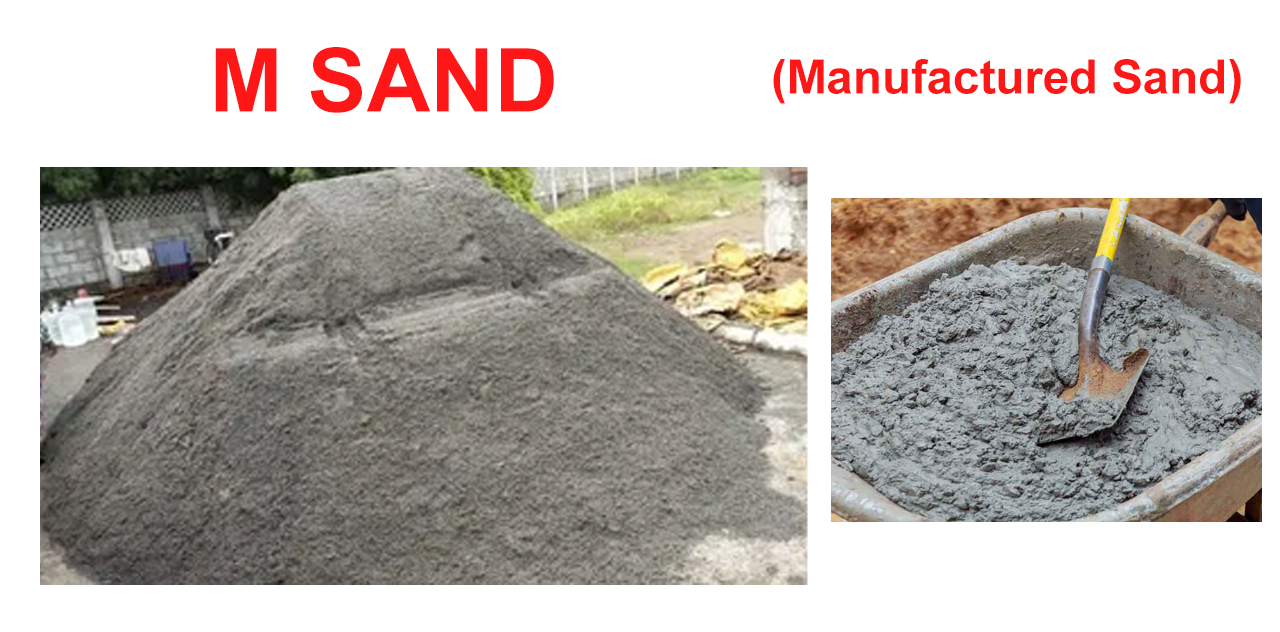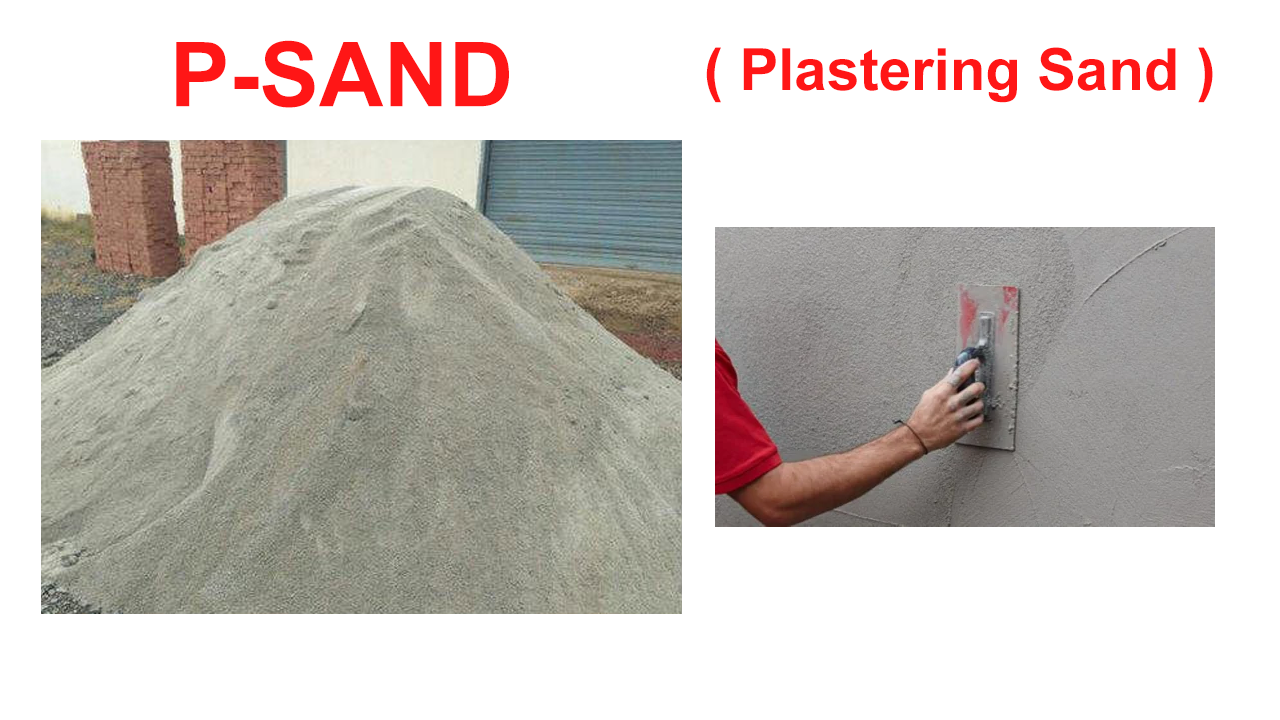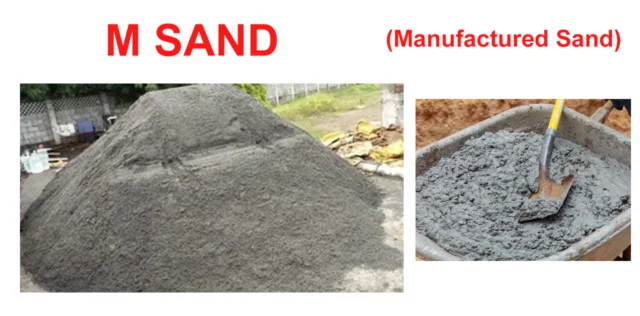What are M-sand and P-sand and River sand?
“M-sand” and “P-sand” refer to distinctive sorts of sand utilized in production. These phrases are normally used within the context of concrete and plastering paintings. Here’s a proof of each:
M-sand (Manufactured Sand):

M-sand is a type of sand made out of difficult granite stone by way of crushing. It is an opportunity for river sand and is regularly utilized in production sports. M-sand is synthetic through a procedure of crushing rocks to supply first-class particles. The blessings of M-sand consist of:
Consistency: M-sand has constant gradation and is freed from impurities.
Environmentally Friendly: It is taken into consideration as a green alternative to river sand, as it’s produced by crushing rocks and would not involve dredging rivers.
Cost-Effective: In a few regions, M-sand can be more simply available and value-powerful in comparison to river sand.
P-sand (Plastering Sand):

P-sand, additionally called plastering sand or satisfactory sand, is a sort of sand used in plastering work for rendering and plastering walls. It is finer than M-sand and is commonly used as a nice combination in mortar for plastering. The traits of P-sand encompass:
Fineness:
P-sand is finer compared to M-sand, making it suitable for attaining an easy finish in plastering packages.
Workability:
The fine particles in P-sand contribute to the workability of the mortar, making it easier to apply and unfold.
Plastering Quality:
P-sand is specially selected for its suitability in plastering programs, in which an easy or even floor is preferred.
In precis, M-sand is a form of sand produced by crushing hard rocks and is regularly used as a replacement for river sand in construction, whilst P-sand, or plastering sand, is a finer form of sand used in particular in plastering programs to acquire an easy end on walls. Both M-sand and P-sand have their programs inside the creation enterprise, and their use depends on the specific requirements of the task.
Usage in Concrete:
M-sand is commonly used instead of river sand in concrete production. It is used as a great aggregate in the training of concrete mixes for various production applications, consisting of homes, bridges, and pavements. The consistent gradation and particle length distribution of M-sand contribute to the electricity and workability of concrete.
Grading and Particle Size:
Both M-sand and P-sand have precise grading necessities. Grading refers to the distribution of particle sizes inside the sand. M-sand is commonly finer than P-sand, with a more uniform particle length distribution. The grading of the sand influences the workability and power of concrete and mortar.
Manufacturing Process:
M-sand is synthetic with the aid of crushing difficult rocks, inclusive of granite or basalt, into exceptional particles. The crushing system includes more than one tier to produce sand with constant satisfaction. On the other hand, P-sand can be natural sand or sand received from the crushing of rocks, however, it’s far in particularly decided on and processed for use in plastering programs.
Availability and Location:
The availability of M-sand and P-sand can vary using area. In some areas, M-sand may be extra without problems to be had and economically feasible as compared to river sand. The availability of suitable P-sand for plastering applications also relies upon local assets.
Regulations and Standards:
Local construction codes and requirements may also specify the permissible forms of sand for one-of-a-kind creation applications. It’s essential to stick to those guidelines to ensure the best and sturdiness of the built systems.
Mix Design Considerations:
When the usage of M-sand or P-sand in concrete blend designs, changes can be essential to account for his or her specific properties. The blend layout needs to take into account factors which include the type of sand, water-cement ratio, and preferred concrete strength. Read also this: How to Calculate Cement, Sand, Aggregate Ratio of a Concrete
Environmental Impact:
M-sand is often considered greater environmentally friendly than river sand because it reduces the want for dredging rivers. However, the environmental impact of sand mining and extraction ought to still be taken into consideration, and sustainable practices need to be advocated.
Quality Control:
Quality manipulation measures are essential during the usage of M-sand and P-sand in construction. Regular checking out for particle length distribution, impurities, and different houses guarantees that the sand meets the specified requirements.
Understanding the houses and applications of M-sand and P-sand is vital for selecting the right fabric for precise creation functions. Consulting with nearby government and adhering to enterprise standards helps make sure that the sand used in creation meets pleasant and sustainability criteria.
River sand

River sand is a certainly going on granular cloth this is frequently used as a key element in production, especially in concrete manufacturing and as a bedding cloth for various varieties of production projects. Here are a few key points about river sand:
Source:
River sand is generally sourced from riverbeds, wherein it is naturally deposited by using rivers over the years. The motion of water and erosion ends in the advent of well-graded sand with several particle sizes.
Particle Size:
River sand consists of a mixture of exceptional particles, ranging from very nice sand to coarse sand. The particle length distribution can vary based totally on the unique location and geological traits of the riverbed.
Usage in Construction:
River sand is commonly used in the construction industry for various programs. One of its primary uses is as a pleasant combination in concrete production. It is likewise used as a base fabric for laying bricks and as a bedding cloth for paving stones and other construction factors.
Strength and Workability:
The use of river sand in concrete contributes to the power and workability of the combination. The well-graded particle sizes assist in filling voids among large debris, enhancing the packing density of the concrete mix.
Limitations:
While river sand is broadly used in construction, there are a few environmental worries related to its extraction. Excessive sand mining from riverbeds can result in environmental degradation, which includes erosion of riverbanks, lack of habitat for aquatic life, and adjustments in river morphology.
Environmental Impact:
The environmental impact of river sand mining has caused extended scrutiny, and in a few areas, rules are in the area to manipulate and manage sand extraction. Sustainable sand mining practices are intended to balance the want for production materials with environmental conservation. Read also this: How to Calculate Weight of Reinforced Steel Rod
Alternative to M-sand:
In a few areas wherein natural resources of synthetic sand (M-sand) are constrained, river sand remains a primary supply for fine mixtures in concrete. However, in areas in which environmental worries or regulatory regulations restrict river sand extraction, M-sand may be promoted as an alternative.
Screening and Washing:
Before being utilized in construction, river sand is often screened and washed to put off impurities, silt, and clay. This system guarantees that the sand meets first-class requirements for creation programs.
Local Variations:
The characteristics of river sand can vary based on the geographical vicinity and the specific river from which it’s sourced. Different rivers deposit sands with unique properties.
When using river sand in construction, it is crucial to comply with local policies, bear in mind environmental sustainability, and ensure that the sand meets the required pleasant standards. As with any creation material, right checking out and excellent manipulation practices are essential for the success of production initiatives.









